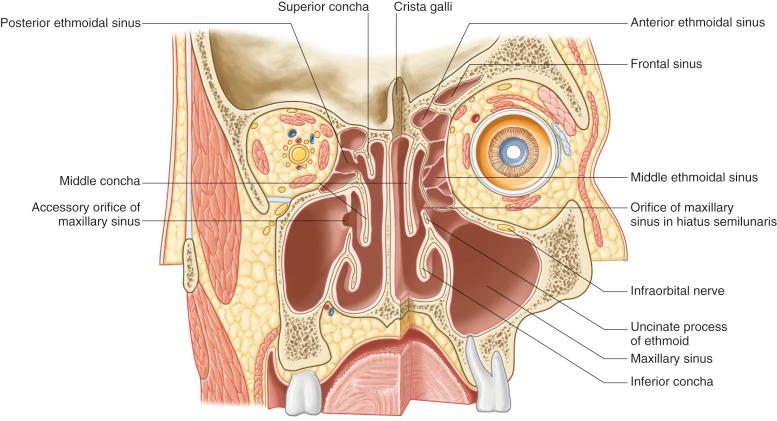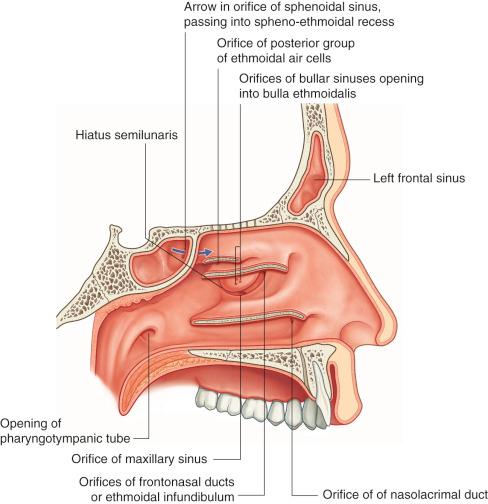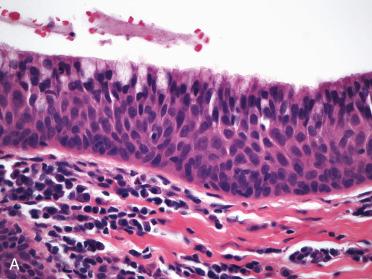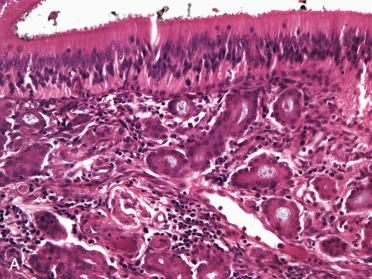Physical Address
304 North Cardinal St.
Dorchester Center, MA 02124
Facial prominences (frontonasal, maxillary, and mandibular) appear around the fourth week of gestation and give rise to the boundaries and structures of the face.
Nasal placodes, representing bilateral thickening of the surface ectoderm along the frontonasal prominence, form the nasal pits, which, by growth of the surrounding mesenchyme, become progressively depressed along their length and give rise to the primitive nasal sacs, the forerunners of the nasal cavities.
Anterior portion of the nasal cavity is the vestibule, the epithelium of which is ectodermally derived and represents the internal extension of the integument of the external nose.
The epithelium lining the nasal cavities proper (Schneiderian membrane) is of ectoderm origin.
Nasal septum develops from the merged medial nasal prominences.
Regions of continuity between the nasal and oral cavities following rupture of the oronasal membrane develop into the choanae.
Conchae (turbinates) develop as elevations along the lateral wall of each nasal cavity.
Olfactory epithelia develop in the superior posterior portion of each nasal cavity and differentiate from cells in the ectodermally derived nasal cavity epithelium.
Nasal cavity is divided into right and left halves by the septum; each half opens on the face via the nares or nostrils and communicates behind with the nasopharynx through the posterior nasal apertures or the choanae.
Each half of the nasal cavity has the following borders (walls):
Superior (roof): slopes downward in front and back and is horizontal in its middle:
Frontal and nasal bones form the anterior sloping part.
Cribriform plate of the ethmoid bone forms the horizontal part and separates the nasal cavity from the anterior cranial fossa (medial part of floor); this area represents the deepest part of the cavity.
Body of the sphenoid bone forms the posterior sloping part.
Inferior (floor): majority (75%) is formed by the palatine processes of the maxillary bone, thereby intervening between the oral and nasal cavities; the remainder is formed by the horizontal process of the palatine bone.
Lateral: formed in the most part by the nasal surface of the maxilla below and in front, posteriorly by the perpendicular plate of the palatine bone, and above by the nasal surface of the ethmoidal labyrinth separating the nasal cavity from the orbit
Along the lateral wall of each nasal cavity are identified three horizontal bony projections: the superior, middle, and inferior conchae; occasionally a small fourth concha is identified above the superior concha and is called the supreme concha.
Air spaces or meatuses (superior, middle, and inferior) lie beneath and lateral to the conchae and are named according to the concha immediately above it.
Medial: formed by the bony nasal septum entirely formed by the vomer and the perpendicular plate of the ethmoid; the anterior portion of the nasal septum represents the septal cartilage.


Innervation of the mucous membranes of the nose is supplied by the ophthalmic and maxillary branches of fifth (trigeminal) nerve via the pterygopalatine (sphenopalatine) ganglion.
Olfactory mucous membrane contains the cells of origin of the olfactory nerve fibers, which collect into bundles traversing the cribriform plate and end in the olfactory bulb.
Arteries and veins:
Arterial supply to the nasal cavity comes from several sources including the sphenopalatine branch of the internal maxillary artery (a branch of the external carotid artery), the anterior and posterior ethmoidal artery branches of the ophthalmic artery (a branch of the internal carotid artery), and the facial artery (a branch of the external carotid artery).
Veins of the nose parallel the arteries with drainage via the sphenopalatine foramen into the pterygoid plexus and then into the internal jugular vein, via the ophthalmic veins into the cavernous sinus and then into the dural venous sinuses, and via the facial vein into either the internal or external jugular vein.
Lymphatics:
Anterior portion of nose drains to the lymphatics, draining the skin covering the external nose, and pass to the submandibular nodes.
Majority of the lymphatics of the nasal cavity drain via the retropharyngeal lymph nodes to the deep cervical lymph nodes.
Nasal vestibule is a cutaneous structure composed of keratinizing squamous epithelium and underlying subcutaneous tissue with cutaneous adnexal structures (hair follicles, sebaceous glands, and sweat glands).
Mucocutaneous junction (limen nasi) is approximately 1 to 2 cm posterior from the nares and represents the point at which the epithelial surface changes from keratinizing squamous epithelium to a ciliated pseudostratified columnar (respiratory) epithelium including identifiable mucocytes (goblet cells); the respiratory epithelium lines the entire nasal cavity and, as previously detailed, is ectodermally derived.
Submucosa underlying the epithelium is thin, is noteworthy for the presence of seromucous (minor salivary) glands arranged in distinct lobules, normally contains a mixed inflammatory cell infiltrate, including mature lymphocytes and scattered plasma cells but no lymphoid follicles/aggregates, and has a distinct vascular component consisting of large, thick-walled blood vessels:
Vascular structures are particularly prominent along the inferior and middle turbinates and may be mistaken for a hemangioma.
Nasal septum separates the nasal cavities and includes elastic cartilage and lamellar bone:
Overlying nasal mucosa is closely apposed to these structures, with the periosteum and perichondrium attached so closely as to constitute a single membrane referred to as mucoperiosteum.
Along the anterior part of the nasal septum the submucosa is rich in thin-walled blood vessels.
Referred to as Little's or Kiesselbach's area
Represents a frequent site of nosebleeds
Nasal cartilage is of the hyaline type and has a bluish, translucent, homogeneous appearance.
Olfactory epithelium consists of: (see Fig. 1-3 )
Bipolar, spindle-shaped olfactory neural (receptor) cells composed of myelinated axons penetrating the basal lamina to protrude from the mucosal surface and nonmyelinated proximal processes, which traverse the cribriform plate
Columnar sustentacular or supporting cells
Rounded basal cells lie on basal lamina
Olfactory or Bowman glands in the lamina propria representing purely serous type glands


Become a Clinical Tree membership for Full access and enjoy Unlimited articles
If you are a member. Log in here